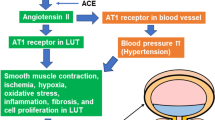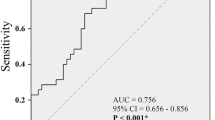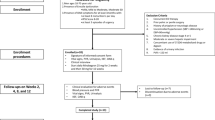Abstract
The main use of α1-adrenoceptor (AR) antagonists in urology has been to treat lower urinary tract symptoms (LUTS) in men with benign prostatic obstruction (BPO). The beneficial effects of these agents are primarily assumed to be because of relaxation of prostatic and urethral smooth muscle. The weak correlation between LUTS and prostatic enlargement, outflow obstruction, or both, however, has refocused interest on the role of extraprostatic α-ARs in the pathogenesis of LUTS and their treatment. The α1-ARs present in the bladder, urethra, vas deferens, peripheral ganglia, nerve terminals, and in the central nervous system could all potentially influence LUTS and, when the receptors are blocked, contribute to both the therapeutic and adverse effects of α1-AR antagonists. The relevance of α1-AR-subtype selectivity on the clinical usefulness of existing drug therapies has not been firmly established but it seems that blockade of both α1A/L- and α1D-ARs is necessary for the optimum balance between clinical efficacy and adverse effects.
Key Points
-
The efficacy of α1-adrenoceptor (AR) antagonists seems to be dependent on blockade of both prostatic/urethral and extraprostatic (bladder, central nervous system) α1-ARs
-
The subtypes of α1-ARs that mediate lower urinary tract symptoms have not been definitely established, but α1-AR antagonists blocking both α1L-ARs and α1D-ARs might produce the most favorable balance between efficacy and adverse effects
-
The clinically most important adverse effects of α1-AR antagonists are cardiovascular/central nervous system effects (hypotension, dizziness, sedation), abnormal ejaculation, and intraoperative floppy iris syndrome
This is a preview of subscription content, access via your institution
Access options
Subscribe to this journal
Receive 12 print issues and online access
$209.00 per year
only $17.42 per issue
Buy this article
- Purchase on Springer Link
- Instant access to full article PDF
Prices may be subject to local taxes which are calculated during checkout
Similar content being viewed by others
References
Mitterberger M et al. (2007) Persistent detrusor overactivity after transurethral resection of the prostate is associated with reduced perfusion of the urinary bladder. BJU Int 99: 831–835
Andersson KE (2003) Storage and voiding symptoms: pathophysiologic aspects. Urology 62 (Suppl 2): 3–10
Jardin A et al. (1998) Alpha-blockers in the treatment of BPH. In 4th International Consultation on Benign Prostatic Hyperplasia (BPH), 599–632 (Eds Denis L et al.). Plymouth: Health Publication Ltd
Rossi C et al. (2001) Alpha-blockade improves symptoms suggestive of bladder outlet obstruction but fails to relieve it. J Urol 165: 38–41
Kessler TM et al. (2006) The effect of terazosin on functional bladder outlet obstruction in women: a pilot study. J Urol 176: 1487–1492
Chapple CR and Roehrborn CG (2006) A shifted paradigm for the further understanding, evaluation, and treatment of lower urinary tract symptoms in men: focus on the bladder. Eur Urol 49: 651–688
Roehrborn CG and Schwinn DA (2004) Alpha1-adrenergic receptors and their inhibitors in lower urinary tract symptoms and benign prostatic hyperplasia. J Urol 171: 1029–1035
Michel MC and Vrydag W (2006) Alpha1-, alpha2- and beta-adrenoceptors in the urinary bladder, urethra and prostate. Br J Pharmacol 147 (Suppl 2): S88–S119
Hampel C et al. (2002) Modulation of bladder alpha1-adrenergic receptor subtype expression by bladder outlet obstruction. J Urol 167: 1513–1521
Nomiya M and Yamaguchi O (2003) A quantitative analysis of mRNA expression of alpha 1 and beta-adrenoceptor subtypes and their functional roles in human normal and obstructed bladders. J Urol 170: 649–653
Bouchelouche K et al. (2005) Increased contractile response to phenylephrine in detrusor of patients with bladder outlet obstruction: effect of the alpha1A and alpha1D-adrenergic receptor antagonist tamsulosin. J Urol 173: 657–661
Ohtake A et al. (2006) Effect of tamsulosin on spontaneous bladder contraction in conscious rats with bladder outlet obstruction: comparison with effect on intraurethral pressure. Eur J Pharmacol 545: 185–191
Tatemichi S et al. (2006) A selective alpha1A-adrenoceptor antagonist inhibits detrusor overactivity in a rat model of benign prostatic hyperplasia. J Urol 176: 1236–1241
Malloy BJ et al. (1998) Alpha1-adrenergic receptor subtypes in human detrusor. J Urol 160: 937–943
Berger AP et al. (2003) Increased growth factor production in a human prostatic stromal cell culture model caused by hypoxia. Prostate 57: 57–65
Das AK et al. (2002) Effect of doxazosin on rat urinary bladder function after partial outlet obstruction. Neurourol Urodyn 21: 160–166
Somogyi GT et al. (1995) Prejunctional facilitatory alpha 1-adrenoceptors in the rat urinary bladder. Br J Pharmacol 114: 1710–1716
Szell EA et al. (2000) Smooth muscle and parasympathetic nerve terminals in the rat urinary bladder have different subtypes of alpha(1) adrenoceptors. Br J Pharmacol 130: 1685–1691
Trevisani M et al. (2007) The influence of alpha(1)-adrenoreceptors on neuropeptide release from primary sensory neurons of the lower urinary tract. Eur Urol [doi:10.1016/j.eururo.2007.01.016]
Birder LA and de Groat WC (2007) Mechanisms of disease: involvement of the urothelium in bladder dysfunction. Nat Clin Pract Urol 4: 46–54
Ishihama H et al. (2006) Activation of alpha1D adrenergic receptors in the rat urothelium facilitates the micturition reflex. J Urol 175: 358–364
Furuya S et al. (1982) Alpha-adrenergic activity and urethral pressure in prostatic zone in benign prostatic hypertrophy. J Urol 128: 836–839
Appell RA et al. (1980) The effects of epidural anesthesia on the urethral closure pressure profile in patients with prostatic enlargement. J Urol 124: 410–411
Andersson KE (2002) Alpha-adrenoceptors and benign prostatic hyperplasia: basic principles for treatment with alpha-adrenoceptor antagonists. World J Urol 19: 390–396
Brading AF et al. (1999) α1-Adrenoceptors in urethral function. Eur Urol 36 (Suppl 1): 74–79
Nasu K et al. (1998) Quantification and distribution of alpha1-adrenoceptor subtype mRNAs in human proximal urethra. Br J Pharmacol 123: 1289–1293
Taki N et al. (1999) Evidence for predominant mediation of alpha1-adrenoceptor in the tonus of entire urethra of women. J Urol 162: 1829–1832
Daniels DV et al. (1999) Human cloned alpha1A-adrenoceptor isoforms display alpha1L-adrenoceptor pharmacology in functional studies. Eur J Pharmacol 370: 337–343
Fukasawa R et al. (1998) The alpha1L-adrenoceptor subtype in the lower urinary tract: a comparison of human urethra and prostate. Br J Urol 82: 733–737
Lepor H and Theune C (1995) Randomized double-blind study comparing the efficacy of terazosin versus placebo in women with prostatism-like symptoms. J Urol 154: 116–118
Nasu K et al. (1996) Quantification and distribution of alpha 1-adrenoceptor subtype mRNAs in human prostate: comparison of benign hypertrophied tissue and non-hypertrophied tissue. Br J Pharmacol 119: 797–803
Kurimoto S et al. (1995) Quantitative autoradiography of alpha 1 adrenoceptors with [3H]tamsulosin in human hypertrophied prostate using computerized image analysis. Histochem J 27: 1007–1013
Walden PD et al. (1999) Localization and expression of the alpha1A-1, alpha1B and alpha1D-adrenoceptors in hyperplastic and non-hyperplastic human prostate. J Urol 161: 635–640
Lepor H et al. (1993) Binding and functional properties of alpha1 adrenoceptors in different regions of the human prostate. J Urol 150: 253–256
Moriyama N et al. (1994) Multidirectional contraction of human hypertrophied prostate. Gen Pharmacol 25: 1459–1464
Morishima S et al. (2007) Identification of alpha-1L and alpha-1A adrenoceptors in human prostate by tissue segment binding. J Urol 177: 377–381
Djavan B and Marberger M (1999) A meta-analysis on the efficacy and tolerability of alpha1-adrenoceptor antagonists in patients with lower urinary tract symptoms suggestive of benign prostatic obstruction. Eur Urol 36: 1–13
Chon JK et al. (1999) Alpha 1-adrenoceptor antagonists terazosin and doxazosin induce prostate apoptosis without affecting cell proliferation in patients with benign prostatic hyperplasia. J Urol 161: 2002–2008
Tahmatzopoulos A and Kyprianou N (2004) Apoptotic impact of alpha1-blockers on prostate cancer growth: a myth or an inviting reality? Prostate 59: 91–100
Ilio KY et al. (2001) Apoptotic activity of doxazosin on prostate stroma in vitro is mediated through an autocrine expression of TGF-beta1. Prostate 48: 131–135
Garrison JB and Kyprianou N (2006) Doxazosin induces apoptosis of benign and malignant prostate cells via a death receptor-mediated pathway. Cancer Res 66: 464–472
McConnell JD et al. (2003) The long-term effect of doxazosin, finasteride, and combination therapy on the clinical progression of benign prostatic hyperplasia. N Engl J Med 349: 2387–2398
Roehrborn CG (2006) Three months' treatment with the alpha1-blocker alfuzosin does not affect total or transition zone volume of the prostate. Prostate Cancer Prostatic Dis 9: 121–125
Smith P et al. (1999) Influence of the alpha1-adrenergic antagonist, doxazosin, on noradrenaline-induced modulation of cytoskeletal proteins in cultured hyperplastic prostatic stromal cells. Prostate 38: 216–227
Boesch ST et al. (1999) Modulation of the differentiation status of cultured prostatic smooth muscle cells by an alpha1-adrenergic receptor antagonist. Prostate 39: 226–233
Brannigan RE (2004) Ejaculatory disorders and lower urinary tract symptoms. Curr Urol Rep 5: 280–286
Carbone DJ Jr and Hodges S (2003) Medical therapy for benign prostatic hyperplasia: sexual dysfunction and impact on quality of life. Int J Impot Res 15: 299–306
Moriyama N et al. (1997) Quantification and distribution of alpha 1-adrenoceptor subtype mRNAs in human vas deferens: comparison with those of epididymal and pelvic portions. Br J Pharmacol 122: 1009–1014
Furukawa K et al. (1995) Alpha 1A-adrenoceptor-mediated contractile responses of the human vas deferens. Br J Pharmacol 116: 1605–1610
Amobi N et al. (1999) Functional characterization of alpha1-adrenoceptor subtypes in longitudinal and circular muscle of human vas deferens. Eur J Pharmacol 367: 291–298
Tambaro S et al. (2005) Evaluation of tamsulosin and alfuzosin activity in the rat vas deferens: relevance to ejaculation delays. J Pharmacol Exp Ther 312: 710–717
Giuliano F et al. (2004) A comparison of the effects of tamsulosin and alfuzosin on neurally evoked increases in bladder neck and seminal vesicle pressure in rats. BJU Int 93: 605–608
Giuliano FA et al. (2006) Comparison between tamsulosin and alfuzosin on the expulsion phase of ejaculation in rats. BJU Int 98: 876–879
Domyancic AV and Morilak DA (1997) Distribution of alpha1A adrenergic receptor mRNA in the rat brain visualized by in situ hybridization. J Comp Neurol 386: 358–378
Day HE et al. (1997) Distribution of alpha 1a-, alpha 1b- and alpha 1d-adrenergic receptor mRNA in the rat brain and spinal cord. J Chem Neuroanat 13: 115–139
Thor KB and Donatucci C (2004) Central nervous system control of the lower urinary tract: new pharmacological approaches to stress urinary incontinence in women. J Urol 172: 27–33
Ishizuka O et al. (1996) Micturition in conscious rats with and without bladder outlet obstruction: role of spinal alpha 1-adrenoceptors. Br J Pharmacol 117: 962–966
Persson K et al. (1998) Spinal and peripheral mechanisms contributing to hyperactive voiding in spontaneously hypertensive rats. Am J Physiol 275: R1366–R1373
Yoshiyama M et al. (2000) Role of spinal alpha(1)-adrenergic mechanisms in the control of lower urinary tract in the rat. Brain Res 882: 36–44
Yoshiyama M and De Groat WC (2001) Role of spinal alpha1-adrenoceptor subtypes in the bladder reflex in anesthetized rats. Am J Physiol Regul Integr Comp Physiol 280: R1414–R1419
Sugaya K et al. (2002) Effects of intrathecal injection of tamsulosin and naftopidil, alpha-1A and -1D adrenergic receptor antagonists, on bladder activity in rats. Neurosci Lett 328: 74–76
Yokoyama O et al. (2006) Improvement of bladder storage function by alpha1-blocker depends on the suppression of C-fiber afferent activity in rats. Neurourol Urodyn 25: 461–467
Chen Q et al. (2005) Function of the lower urinary tract in mice lacking alpha1d-adrenoceptor. J Urol 174: 370–374
Mitsui T et al. (2005) Transplantation of neuronal and glial restricted precursors into contused spinal cord improves bladder and motor functions, decreases thermal hypersensitivity, and modifies intraspinal circuitry. J Neurosci 25: 9624–9636
Blue D et al. (2002) RO700004, a selective α1A-adrenoceptor antagonist, does not improve lower urinary tract symptoms in men with benign prostatic hyperplasia [abstract]. J Urol 167 (Suppl): 265
Ikemoto I et al. (2003) Usefulness of tamsulosin hydrochloride and naftopidil in patients with urinary disturbances caused by benign prostatic hyperplasia: a comparative, randomized, two-drug crossover study. Int J Urol 10: 587–594
Gotoh M et al. (2005) Comparison of tamsulosin and naftopidil for efficacy and safety in the treatment of benign prostatic hyperplasia: a randomized controlled trial. BJU Int 96: 581–586
Nishino Y et al. (2006) Comparison of two alpha1-adrenoceptor antagonists, naftopidil and tamsulosin hydrochloride, in the treatment of lower urinary tract symptoms with benign prostatic hyperplasia: a randomized crossover study. BJU Int 97: 747–751
Kawabe K et al. (2006) Silodosin, a new alpha1A-adrenoceptor-selective antagonist for treating benign prostatic hyperplasia: results of a phase III randomized, placebo-controlled, double-blind study in Japanese men. BJU Int 98: 1019–1024
Barendrecht MM et al. (2005) Treatment of lower urinary tract symptoms suggestive of benign prostatic hyperplasia: the cardiovascular system. BJU Int 95 (Suppl 4): 19–28
ALLHAT Collaborative Research Group (2000) Major cardiovascular events in hypertensive patients randomized to doxazosin vs chlorthalidone: the antihypertensive and lipid-lowering treatment to prevent heart attack trial (ALLHAT). JAMA 283: 1967–1975
Stafford RS et al. (2004) Impact of clinical trial results on national trends in alpha-blocker prescribing, 1996–2002. JAMA 291: 54–62
Hartung R et al. (2006) Age, comorbidity and hypertensive co-medication do not affect cardiovascular tolerability of 10 mg alfuzosin once daily. J Urol 175: 624–628
Elhilali M et al. (2006) Long-term efficacy and safety of alfuzosin 10 mg once daily: a 2-year experience in 'real-life' practice. BJU Int 97: 513–519
Michel MC and Chapple CR (2006) Comparison of the cardiovascular effects of tamsulosin oral controlled absorption system (OCAS) and alfuzosin prolonged release (XL). Eur Urol 49: 501–508
Auerbach SM et al. (2004) Simultaneous administration of vardenafil and tamsulosin does not induce clinically significant hypotension in patients with benign prostatic hyperplasia. Urology 64: 998–1003
Giuliano F et al. (2006) Hemodynamic interaction study between the alpha1-blocker alfuzosin and the phosphodiesterase-5 inhibitor tadalafil in middle-aged healthy male subjects. Urology 67: 1199–1204
Chung BH and Hong SJ (2006) Long-term follow-up study to evaluate the efficacy and safety of the doxazosin gastrointestinal therapeutic system in patients with benign prostatic hyperplasia with or without concomitant hypertension. BJU Int 97: 90–95
Kirby RS (1995) Doxazosin in benign prostatic hyperplasia: effects on blood pressure and urinary flow in normotensive and hypertensive men. Urology 46: 182–186
Lowe FC (1994) Safety assessment of terazosin in the treatment of patients with symptomatic benign prostatic hyperplasia: a combined analysis. Urology 44: 46–51
Kaplan SA and D'Alisera PM (1998) Tolerability of alpha-blockade with doxazosin as a therapeutic option for symptomatic benign prostatic hyperplasia in the elderly patient: a pooled analysis of seven double-blind, placebo-controlled studies. J Gerontol A Biol Sci Med Sci 53: M201–M206
Os I and Stokke HP (1999) Effects of doxazosin in the gastrointestinal therapeutic system formulation versus doxazosin standard and placebo in mild-to-moderate hypertension. Doxazosin Investigators' Study Group. J Cardiovasc Pharmacol 33: 791–797
Buzelin JM et al. (1997) Comparison of tamsulosin with alfuzosin in the treatment of patients with lower urinary tract symptoms suggestive of bladder outlet obstruction (symptomatic benign prostatic hyperplasia). The European Tamsulosin Study Group. Br J Urol 80: 597–605
Lepor H et al. (2000) The mechanism of adverse events associated with terazosin: an analysis of the Veterans Affairs cooperative study. J Urol 163: 1134–1137
De Mey C (2000) Alpha1-blocker therapy for lower urinary tract symptoms suggestive of benign prostatic obstruction: what are the relevant differences in randomised controlled trials? Eur Urol 38 (Suppl 1): 25–39
Os I (2006) Comparison of doxazosin GITS and standard doxazosin in the treatment of high blood pressure. Int J Clin Pharmacol Ther 44: 99–106
Mottet N et al. (2003) Prostatic tissual distribution of alfuzosin in patients with benign prostatic hyperplasia following repeated oral administration. Eur Urol 44: 101–105
Becker AJ et al. (1998) Oral phentolamine as treatment for erectile dysfunction. J Urol 159: 1214–1216
Schulman C (2001) Impact of treatment of BPH on sexuality. Prostate Cancer Prostatic Dis 4: S12–S16
Hellstrom WJ and Sikka SC (2006) Effects of acute treatment with tamsulosin versus alfuzosin on ejaculatory function in normal volunteers. J Urol 176: 1529–1533
Hisasue S et al. (2006) Ejaculatory disorder caused by alpha-1 adrenoceptor antagonists is not retrograde ejaculation but a loss of seminal emission. Int J Urol 13: 1311–1316
van Dijk MM et al. (2006) Effects of alpha(1)-adrenoceptor antagonists on male sexual function. Drugs 66: 287–301
Speakman M (2006) Efficacy and safety of tamsulosin OCAS. BJU Int 98 (Suppl 2): 13–17
Goktas S et al. (2006) Recovery of abnormal ejaculation by intermittent tamsulosin treatment. J Urol 175: 650–652
Chang DF and Campbell JR (2005) Intraoperative floppy iris syndrome associated with tamsulosin. J Cataract Refract Surg 31: 664–673
Oshika T et al. (2007) Incidence of intraoperative floppy iris syndrome in patients on either systemic or topical alpha(1)-adrenoceptor antagonist. Am J Ophthalmol 143: 150–151
Lawrentschuk N and Bylsma GW (2006) Intraoperative 'floppy iris' syndrome and its relationship to tamsulosin: a urologist's guide. BJU Int 97: 2–4
Schwinn DA and Afshari NA (2006) alpha(1)-Adrenergic receptor antagonists and the iris: new mechanistic insights into floppy iris syndrome. Surv Ophthalmol 51: 501–512
Author information
Authors and Affiliations
Corresponding author
Ethics declarations
Competing interests
The authors declare no competing financial interests.
Rights and permissions
About this article
Cite this article
Andersson, KE., Gratzke, C. Pharmacology of α1-adrenoceptor antagonists in the lower urinary tract and central nervous system. Nat Rev Urol 4, 368–378 (2007). https://doi.org/10.1038/ncpuro0836
Received:
Accepted:
Issue Date:
DOI: https://doi.org/10.1038/ncpuro0836
This article is cited by
-
BOO induces fibrosis and EMT in urothelial cells which can be recapitulated in vitro through elevated storage and voiding pressure cycles
International Urology and Nephrology (2021)
-
Akuter Harnverhalt bei Männern: Die Wirksamkeit von Alpha-Blockern beim Katheterauslassversuch nach Harnverhalt
Der Urologe (2019)
-
Pharmacotherapy for Nocturia
Current Urology Reports (2018)
-
Elevated hydrostatic pressure stimulates ATP release which mediates activation of the NLRP3 inflammasome via P2X4 in rat urothelial cells
International Urology and Nephrology (2018)



